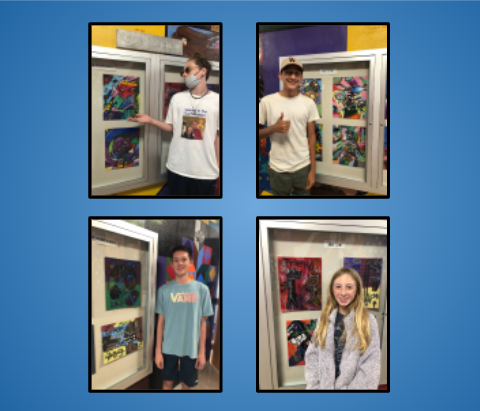Dla Ludzi Gallery: Basquiat Paintings/Cubist Portraits

Artists next to their piece in the Dla Ludzi Gallery.
April 27, 2022
Art pieces were recently incorporated into the Dla Ludzi Gallery. These creations were part of the “Basquiat Painting” and “Cubist Portrait” projects of Swihart’s Advanced Art and Art ⅞ classes. Both projects achieve a special, complex look by employing abstract and creative concepts to produce moving visuals that have been pioneered by artists past. The projects were characterized by special touches such as a symbolic object and the inclusion of oil pastel in the process.
David Shorter of the “Cubist Portrait” paintings believes that Pablo Picasso’s style incorporates complex geometry, many points of view, and swift creative decisions. Shorter relates to the artistic style and enjoys how it looks. He mentioned that this project was his first time working with oil pastels; a helpful tip he gives is to be sparing in the application of pigment. Shorter illustrated a cactus pen given to him by a friend as a symbolic object in his project, explaining, “I wanted to show my friendship and the sentimental value a small trinket can have.”
Jude Nelson, another artist of the project, admitted, “Picasso’s cubist style is [like] letting your mind onto the paper.” Nelson relates to the artistic style because he likes to draw whatever comes to mind. He reported having prior experience in oil painting, and advises avoiding heavy use of black, as it may alter the other colors being used; if one wants to include dark shades, Nelson recommends using a dark version of the regular color. He used a spider web as a form of symbolism in his piece.
Riley Kuhlendahl of the “Basquiat Painting” project described Jean-Michael Basquiat’s art style as “chaotic” and “child-like.” Kuhlendahl felt that her style differs from his, as her look consists of both cartoonish and realistic features. Kuhlendahl found the process lengthy, and she waved her painting around to dry it so that she got more of the different details of the painting done each day. A piece of advice she gave was to let the art turn messy and disordered, as this disorganization is characteristic of the particular art style. She noted that the symbolic object in her piece was a teddy bear she has owned for a long time; She remarked, “I thought that it is kind [like] of how [Basquiat’s] work is old, worn, and crazy.”
Ryder Wells of the same project interprets Basquiat’s technique to be characterized by high energy and the use of simple shades; Wells finds his style similar to Basquiat’s. Both Wells and Kuhlendahl found that this assignment was their first time working to produce abstract art. Wells also found that this kind of painting takes some time, but he found it enjoyable to work with the oil pastel once the paint had dried. He stated that the symbolic object included in his art project was his dog “because I love him, he keeps me company when I’m bored, and he is super cute.” Wells believes that the meaning of the painting consists of “drawing words that [are] in mind [while looking] at the painting.”
In short, these art pieces were all about self-expression, distinct styles, and symbolism. The execution of combining these specific artistic ideas with the canvas has produced truly moving visuals for the gallery, and these pieces are sure to have a significant, lasting impact on those who view them.

